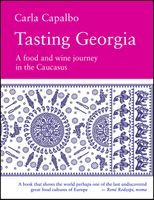Label
All
0
Clear all filters
Save 25% on ckbk Premium Membership with code FALLFLAVORS 🍁
Tbilisi
Appears in
Published 2017

Abanotubani, the historic sulphur bath district in Tbilisi

Metekhi bridge and church, with the equestrian statue of King Vakhtang Gorgasali
Whenever I arrive in Tbilisi I’m reminded of Alexandre Dumas’s colourful descriptions of the city as it was in the 1850s. I love imagining the hilly lanes near the Persian baths crowded with camels, and the costumed people from distant countries leading mules packed with silks and spices into the caravanserais.
The spice traders and their camels may be long gone but some of that exoticism endures in Tbilisi’s older districts of wooden houses with fret-worked balconies and shady tree-lined streets. They offer an exciting contrast to the modern structures by international architects that now punctuate the city on both sides of the Kura, or Mtkvari, River.
In this section
Advertisement
Advertisement
The licensor does not allow printing of this title


